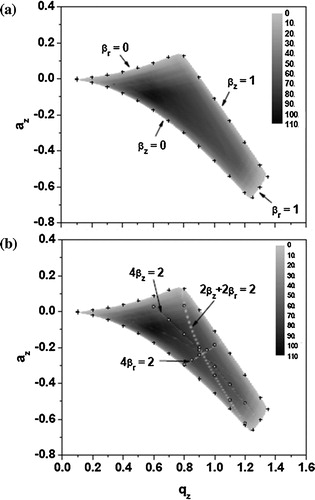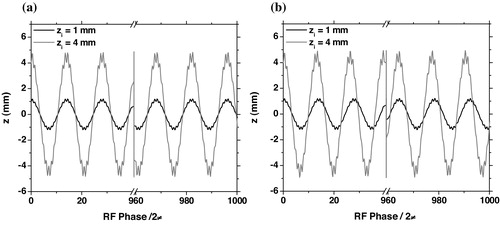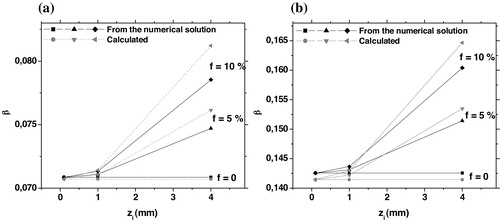 ?Mathematical formulae have been encoded as MathML and are displayed in this HTML version using MathJax in order to improve their display. Uncheck the box to turn MathJax off. This feature requires Javascript. Click on a formula to zoom.
?Mathematical formulae have been encoded as MathML and are displayed in this HTML version using MathJax in order to improve their display. Uncheck the box to turn MathJax off. This feature requires Javascript. Click on a formula to zoom.Abstract
The power series method is used to solve numerically the equation of motion of ions in a radiofrequency quadrupole ion trap when a small octopolar potential is present. Every time step, the coordinates of the ion are represented by a truncated series of degree 15. The stability diagram of the trap is obtained by using the method to simulate the behavior of hundreds of ions up to a relatively large time. The nonlinear resonance lines are observed. The ion's oscillation frequencies are then studied. Their theoretical expression is derived and compared to the results of the truncated series solution.
1 Introduction
The radiofrequency quadrupole ion trap is a small and versatile device which allows to maintain ions in a small volume of space by the application of a DC and a radiofrequency voltage. Since its invention in the 1950s by W. Paul and H. Steinwedel, it found multiple applications in physics, chemistry, biology, pharmacology and environmental sciences [Citation1]. It is made of a ring having the radius r0 closed by two end-caps located at the distance z0 from the trap's center [Citation2]. Usually . The three electrodes have hyperboloidal shape. The end-caps are connected together and a voltage UDC + VAC cos Ωt is applied between them and the ring.
Ideally, the potential generated in the volume of the trap is quadrupolar but for real traps it is more complicated. Its general expression in the spherical coordinates (ρ, θ, φ) is given by [Citation3]
(1)
(1) bn are constants and Pn the Legendre polynomial of order n. If in addition, the trap has a symmetry about the z = 0 plane (z is the trap's axis), only the even terms have to be considered [Citation4]. By taking only the terms of order 2 and 4, the potential Equation(1)
(1)
(1) can be written in Cartesian coordinates as [Citation5]
(2)
(2) A2 is equal to 1 for ideal traps and f is a constant related to the strength of the octopolar contribution.
The equation of motion for an ion of mass m and charge q under the action of the potential Equation(2)(2)
(2) is
(3)
(3) where u = x, y or z, r2 = x2 + y2,
and
(4)
(4) au and qu are the Mathieu parameters which have the expressions
(5)
(5)
A trapped ion performs oscillations with the fundamental frequencies [Citation5]. βu is function of the Mathieu parameters.
The trapping is possible only for qz and az chosen in some regions of the (qz, az) plane. The usual region is called the lowest stability domain and corresponds to βz and βx = βy (noted βr) having the values between 0 and 1 [Citation6].
Simulations of the trapped ions dynamics in radiofrequency quadrupole ion traps have been realized since decades now [Citation7,Citation8]. The positions and velocities of every ion are calculated by solving numerically the equation of motion or using its analytical solution. The power series method has also been used to solve numerically the ion's equation of motion [Citation9,Citation10]. It allows to get accurate results with a relatively small calculation time. The trajectories of hundreds of ions up to several milliseconds can be calculated very quickly. This is useful when some parameters such as the Mathieu parameters are scanned with small steps. Several thousands of cases can be studied in few hours.
2 Resolution of the trapped ion equation of motion using the power series method
The use of the power series method for the resolution of the trapped ion equation of motion is explained in details in Refs. [Citation9,Citation10]. The variable ξ = Ωt (RF phase) is considered. To calculate the velocity and the position of an ion from t = 0 to tmax, the time step Δt is taken equal to 19% of the RF period . For the Nth step the coordinates x, y and z are represented by the truncated series
(6)
(6) with Δξ = ΩΔt = 0.38π. The coefficients A0, A1, B0, B1, C0 and C1 are obtained from the initial conditions for N = 0, then by imposing the continuity of the position and the velocity for the other steps. The other coefficients are given by recursion relations.
3 Simulation of the trap's stability diagram
The truncated series solution of the ion's equation of motion can be used to simulate the first stability domain for a radiofrequency quadrupole trap. For that we considered the evolution of the position of 200 ions of mass 1 amu up to 10,000 periods of the RF field (ξmax = 2 ×104π) in a trap having r0 = 7 mm and z0 = 5 mm. The ions were first generated inside the trap volume with uniform random positions and Maxwellian velocities with the temperature 1000 K. They were considered individually and the trajectory of each one of them was calculated before considering the next one. To be trapped, the coordinates x, y and z must inside the volume of the trap which has hyperboloidal electrodes. The trapping conditions are then
(7)
(7)
This is tested every time step. If the test is negative, the ion is considered as lost and the calculations stopped for it. At ξ = ξmax the number of ions remaining trapped for a working point (qz, az) is counted.
The number of ions trapped up to ξmax as function of the Mathieu parameters is shown in in grayscale map. qz was scanned from 0 to 1.5 with a step of 0.0111 and az taken from -0.5 to 0.2 with a step of 0.0044. The limits of the trapping domain obtained here correspond to those calculated using the recursion formula for the determination of βz and βr [Citation6]. (a) corresponds to an ideal trap with f = 0 and (b) is obtained with f = 0.005. The main difference between the 2 graphs is the appearance of lines in the domain with reduced number of trapped ions. These are called the non linear resonances and occur when [Citation3]
(8)
(8) nr, nz and n are integers such that |nr| + |nz| is the minimum order of the potential inducing these resonances (here 4). In (b), we identify the lines 4βz = 2, 4βr = 2 and 2βz + 2βr = 2. They have been observed experimentally [Citation11] when H+ ions were stored in a radiofrequency quadrupole ion trap having the same r0 and z0 we considered.
4 Ion's oscillation frequencies
For the ideal trap, the ion's oscillation frequencies are only function of the Mathieu parameters az and qz [Citation6]. When the octopolar potential is present, the frequencies are also function of its strength (function of f) and of the amplitudes of the oscillations [Citation5]. To see this effect using our simulation method, we studied the motion of an ion in the z-direction. We considered an ion starting from rest at t = 0 and z = zi. We took az = 0 and different small values for qz and f. The calculations were done up to 1000 periods of the RF voltage (ξmax = 2 ×103π). give the results for qz = 0.2, and zi = 1 and 4 mm. (a) is obtained for f = 0 and (b) is for f = 0.05. As expected the oscillation frequencies are the same for the first case while they are different for the second. The frequency is larger for larger values of the amplitude. In all cases, we can estimate the fundamental frequency and its corresponding amplitude by fitting the curves using a sine function.
In order to calculate the frequencies for the cases we treated, we consider the ion's equation of motion Equation(3)(3)
(3) for z and with az = 0. This is
(9)
(9) with
.
The general solution is [Citation5]
(10)
(10) c2n are constants. By considering only the terms for n = 0, 1 and −1, we can write
(11)
(11)
We suppose that A is much larger than B and C. Then
(12)
(12)
Neglecting the terms with B2, B3, C2, C3, BC, and keeping only the terms with cos βτ, cos(β + 2)τ and cos(β − 2)τ we get
(13)
(13)
(14)
(14)
Replacing Equation(12)(12)
(12) –Equation(14)
(14)
(14) in Eq. Equation(9)
(9)
(9) We have
(15)
(15)
This gives
(16)
(16)
(17)
(17)
(18)
(18)
The initial condition gives the equation
(19)
(19)
For small values of β, Eqs. Equation(17)(17)
(17) and Equation(18)
(18)
(18) give
(20)
(20)
(21)
(21)
Eqs. Equation(19)(19)
(19) –Equation(21)
(21)
(21) then give
(22)
(22)
Neglecting the term , we find
(23)
(23)
This equation with Eqs. Equation(16)(16)
(16) and Equation(19)
(19)
(19) give
(24)
(24) Which reduces to the expression of the adiabatic approximatiopn for f = 0 [Citation6]. In , we show the values of beta that we get from the truncated series solution of the equation of motion and those obtained using Eqs. Equation(23)
(23)
(23) and Equation(24)
(24)
(24) . We considered zi = 0.1, 1 and 4 mm. For each one of these values, we took f = 0%, 5% and 10%. (a) is for qz = 0.1 and (b) for qz = 0.2. There is a good agreement between the simulation and the calculation. We have 3.4% difference in the worst case.
5 Conclusion
The equations of motion of ions in a radiofrequency quadrupole ion trap are solved numerically by representing the coordinates of the ions by truncated series of degree 15 and using recursion relations for the coefficients of the series. By considering the evolution of the position of hundreds of ions up to several thousands of periods of the RF field and counting the number of ions which remain in the geometrical limits of the trap, the stability diagram is obtained for an ideal trap and when an octopolar potential is added. The non linear resonances are observed. The calculations are possible thanks to the reduced computational time the method allows.
The method shows the variation of the ion's oscillation frequencies with the amplitude when the octopolar potential is present. For small value of the Mathieu parameter qz, these variations are in good agreement with what is expected from the theory.
Acknowledgements
The present work has been accomplished under the project No. 09-ADV826-07 funded by KACST (King Abdul Aziz City for Science and Technology) through the Long Term Comprehensive National Plan for Science, Technology and Innovation program in Saudi Arabia.
Notes
Peer review under responsibility of Taibah University.
References
- C.HaoR.E.MarchIon trap mass spectromety, a survey of recent research activity in quadrupole ion trap mass spectrometryInt. J. Mass Spectrom.2122001337357
- F.G.MajorV.N.GheorgheG.WerthCharged Particles Traps. Physics and Techniques of Charged Particles Field Confinement2005Springer-VerlagBerlin, Heidelberg
- Y.WangJ.FranzenK.P.WanczekThe non-linear resonance ion trap. Part 2. A general theoretical analysisInt. J. Mass Spectrom. Ion Processes1241993125
- D.M.EadesJ.V.JohnsonR.A.YostNonlinear Resonance Effects During Ion Storage in a Quadrupole Ion TrapJ Am Soc Mass Spectrom41993917
- S.SevugarajanA.G.MenonA simulation study of coupled secular oscillations in nonlinear Paul trap mass spectrometersInt. J. Mass Spectrom.2092001209
- R.E.MarchAn introduction to quadrupole ion trap mass spectrometryJ. Mass Spectrom.321997351
- H.P.ReiserR.K.JulianJr.R.Graham CooksA versatile method of simulation of the operation of ion trap mass spectrometersInt. J. Mass Spectrom. Ion Processes12119924963
- F.A.LondryR.L.AlfredR.E.MarchComputer simulation of single-ion trajectories in paul-type ion trapsJ. Am. Soc. Mass Spectrom.41993 March687705
- M.S.HerbaneMinimized computational time method for the dynamics of ions trapped in an ideal quadrupole ion trapInt. J. Mass Spectrom.303201173
- M.S.HerbaneH.BerricheA.Abd El-HadyG.Al ShahraniG.BanX.FlechardE.LienardSimulation of ion behavior in an open three-dimensional Paul trap using a power series methodNucl. Instrum. Meth. A751C20141118
- R.AlheitC.HennigR.MorgensternF.VedelG.WerthObservation of instabilities in a Paul trap with higher order anharmonocitiesAppl. Phys. B611995277



